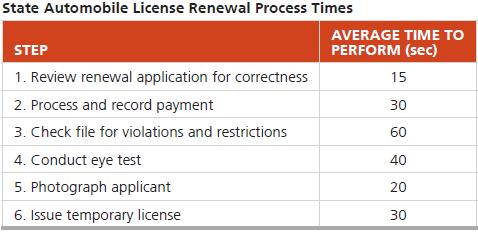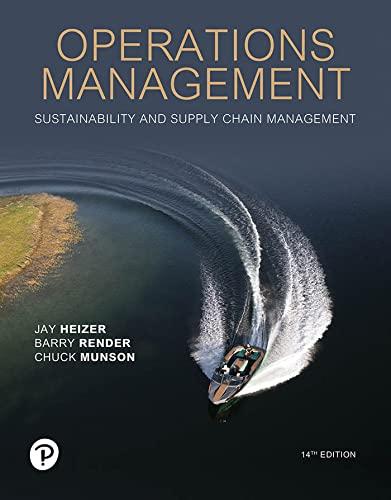LaToya Clarendon, the manager of a metropolitan branch office of the state department of motor vehicles, attempted
Question:
LaToya Clarendon, the manager of a metropolitan branch office of the state department of motor vehicles, attempted to analyze the driver’s license-renewal operations. She had to perform several steps. After examining the license-renewal process, she identified those steps and associated times required to perform each step, as shown in the following table:
LaToya found that each step was assigned to a different person. Each application was a separate process in the sequence shown. She determined that her office should be prepared to accommodate a maximum demand of processing 120 renewal applicants per hour. She observed that work was unevenly divided among clerks and that the clerk responsible for checking violations tended to shortcut her task to keep up with the others. Long lines built up during the maximum-demand periods. LaToya also found that Steps 1 to 4 were handled by general clerks who were each paid $24 per hour. Step 5 was performed by a photographer paid $32 per hour. (Branch offices were charged $20 per hour for each camera to perform photography.) Step 6, issuing temporary licenses, was required by state policy to be handled by uniformed motor vehicle officers. Officers were paid $36 per hour but could be assigned to any job except photography. A review of the jobs indicated that Step 1, reviewing applications for correctness, had to be performed before any other step could be taken. Similarly, Step 6, issuing temporary licenses, could not be performed until all the other steps were completed. LaToya Clarendon was under severe pressure to increase productivity and reduce costs, but she was also told by the regional director that she must accommodate the demand for renewals. Otherwise, “heads would roll.”
Discussion Questions1. What is the maximum number of applications per hour that can be handled by the present configuration of the process?2. How many applications can be processed per hour if a second clerk is added to check for violations?3. Using the original personnel, is there a way to combine stations to increase the maximum number of applications the process can handle? What is the new configuration, and what is the new output per hour?4. How would you suggest modifying the process to accommodate 120 applications per hour? (This may include hiring more staff. And if a second photographer is needed, a second camera would be needed as well.) What is the cost per application of this new configuration?
Step by Step Answer:

Operations Management Sustainability And Supply Chain Management
ISBN: 9780137476442
14th Edition
Authors: Jay Heizer, Barry Render, Chuck Munson





